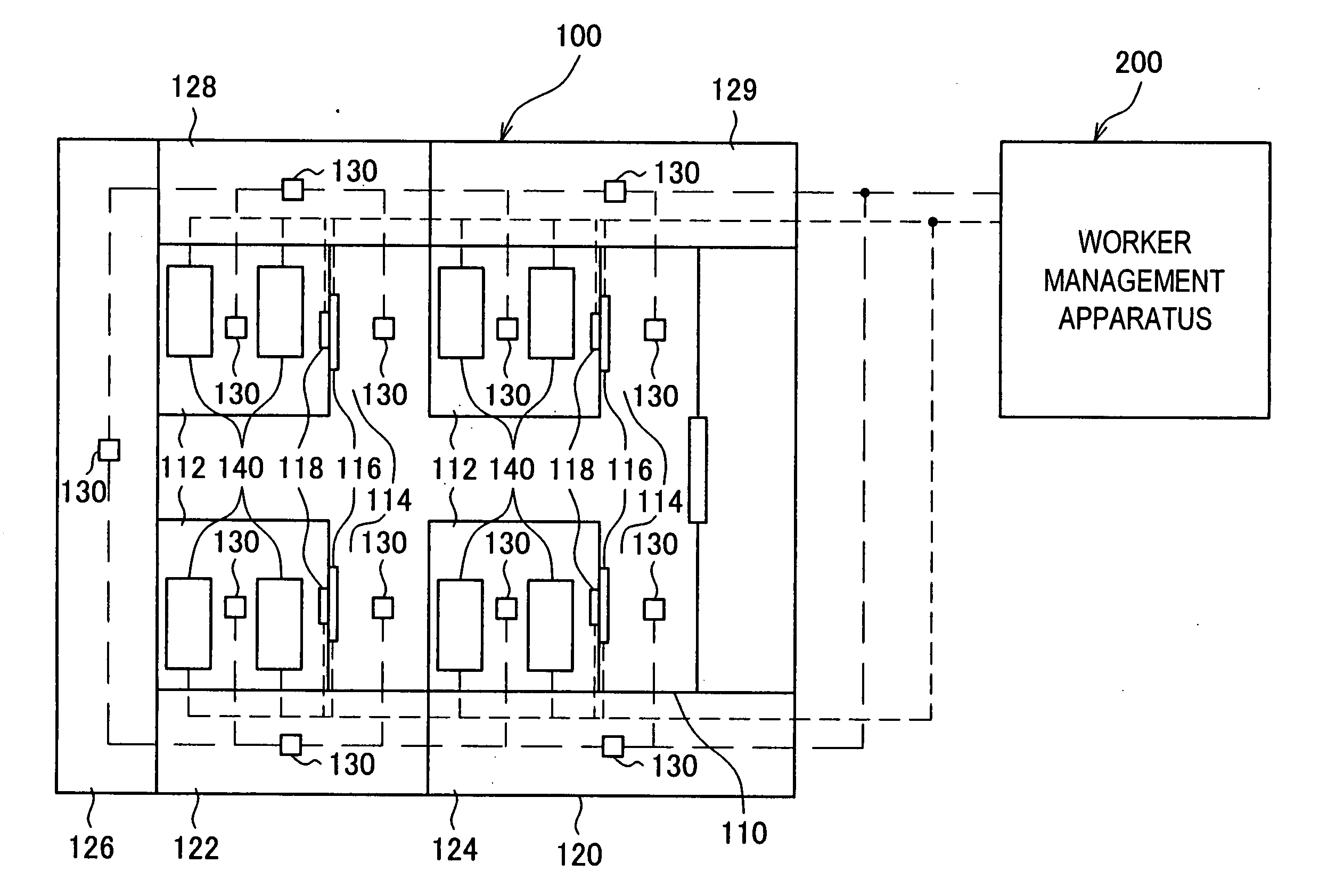Worker management system, worker management apparatus and worker management method
a management system and worker technology, applied in the field of worker management system, worker management apparatus and worker management method, can solve the problems of individual workers not being able to achieve maximum work efficiency, inconvenient to carry out in practice, and workers not being able to take on new tasks, etc., to and facilitate the detection of the exact work area
- Summary
- Abstract
- Description
- Claims
- Application Information
AI Technical Summary
Benefits of technology
Problems solved by technology
Method used
Image
Examples
first embodiment
[0204] First, the worker management system achieved in the first embodiment by adopting the present invention in a semiconductor manufacturing plant is explained in reference to drawings. FIG. 1 shows an example of a floor plan inside a semiconductor manufacturing plant 100 which constitutes the work site in the embodiment by way of showing the overall structure adopted in the worker management system at the semiconductor manufacturing plant. Reference numeral 200 indicates a worker management apparatus.
[0205] As shown in FIG. 1, the area inside the semiconductor manufacturing plant 100 is largely divided into two areas, i.e., a clean room area 110 and an area 120 excluding the clean room (hereafter referred to as a “non-clean room area”).
[0206] The clean room area 110 is further divided into a plurality of equipment room areas 112 and an area other than the equipment rooms (hereafter referred to as a “non-equipment room area”). Semiconductor manufacturing devices 140 such as proc...
second embodiment
[0290] Next, the worker management system achieved in the second embodiment by adopting the present invention in a semiconductor manufacturing plant is explained in reference to drawings. It is to be noted that since the structural features shown in FIGS. 1 through 10 also apply to the second embodiment, a repeated explanation thereof is omitted. In addition, the same reference numerals are assigned to components similar to those in the first embodiment to preclude the necessity for a detailed explanation thereof.
[0291] Another specific example of new task assignment processing that may be executed at the worker management apparatus 200 in the second embodiment is now explained in reference to FIGS. 15 and 16. It is to be noted that the processing executed in the embodiment may be typically achieved in the form of a program recorded in a recording medium such as a hard disk device.
[0292] The new task assignment processing executed in the second embodiment differs from the processi...
third embodiment
[0304] Next, the worker management system achieved in the third embodiment by adopting the present invention in a semiconductor manufacturing plant is explained in reference to drawings. It is to be noted that since the structural features shown in FIGS. 1 through 10 also apply to the third embodiment, a repeated explanation thereof is omitted. In addition, the same reference numerals are assigned to components similar to those in the first embodiment to preclude the necessity for a detailed explanation thereof. It is to be noted that the processing executed in the embodiment may be typically achieved in the form of a program recorded in a recording medium such as a hard disk device.
[0305] Processing executed to create a task database is now explained in reference to FIG. 17 as an example of the task information storage part included in the worker management apparatus 200 achieved in the third embodiment. The task database is used when preparing a daily task report for each worker,...
PUM
 Login to View More
Login to View More Abstract
Description
Claims
Application Information
 Login to View More
Login to View More - R&D
- Intellectual Property
- Life Sciences
- Materials
- Tech Scout
- Unparalleled Data Quality
- Higher Quality Content
- 60% Fewer Hallucinations
Browse by: Latest US Patents, China's latest patents, Technical Efficacy Thesaurus, Application Domain, Technology Topic, Popular Technical Reports.
© 2025 PatSnap. All rights reserved.Legal|Privacy policy|Modern Slavery Act Transparency Statement|Sitemap|About US| Contact US: help@patsnap.com



